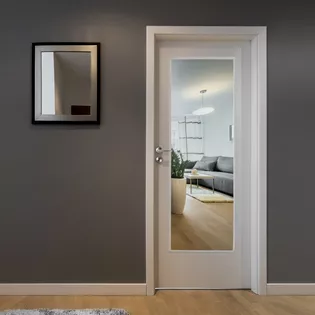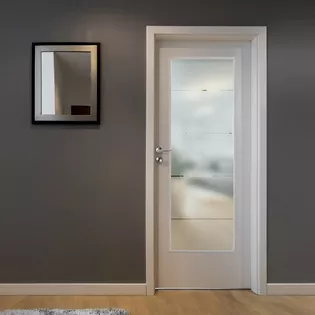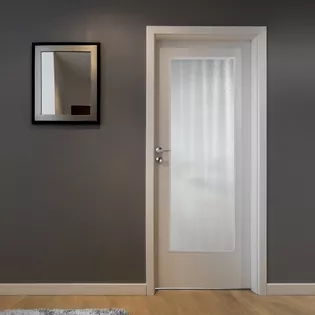Wooden door with glass: The light cut-out guide
Wood is the oldest door material since solid doors have existed and has lasted until today for good reason: Wood is stable, easy to work with and radiates a natural warmth. But when light is required, glass doors are the better choice - or a combination of wood and glass.
To retain the cosiness and naturalness of wood in the room and still allow light to stream in, there are wooden doors with light cut-outs. A light cut-out, also called a glass insert or glass cut-out, is an opening in the wooden door into which a pane is inserted. Light cut-outs make any room visually larger and brighter. They improve the quality of living, especially in small, narrow flats. Light cut-outs can have different sizes, shapes and designs depending on taste, furnishing style and function of the room:
What are there for light cut-outs?
There are almost no limits to the design possibilities with light cut-outs. This makes them a strong design element. As a general rule, the smaller and darker the room, the larger the light cut-out. Large-area, rectangular light cut-outs are the means of choice in this case. This can even go so far that the end result looks like a glass door with a wide wooden frame.
Those who like it more playful can create beautiful effects with the design of the glass cut-out: A larger "window", divided into several small units with wooden bars, evokes associations with cosy old farmhouses and therefore fits perfectly with the country house style or modern country. You emphasise this even more if you choose the upper edge of the light cut-out to be semicircular or curved. Doors like this look particularly good between the hallway and living room, living room and kitchen or hallway and kitchen.
If the design effect is more important than the incident light, the light cut-out can also be smaller. This is the case if the room is either very large or has a large window in another location, or both. A round porthole, for example, is a special eye-catcher for a home office door or a spacious bathroom. A narrow, long, vertical light strip goes particularly well with furnishings in minimalist design, industrial style or modern living. This design is also suitable for office buildings, in combination with clear glass, because it provides an overview of what is happening in the corridor, but does not let too many people look into the office.



Light cut-outs: Which type of glass is the right one?
There are just as many options when it comes to choosing the glass as there are when it comes to the size, positioning and shape of the light cut-out. Our clear glass in Pure White quality lets the most light through. It is ideal for creating the illusion of a larger room or connecting two rooms. Clear glass, whether in Pure White or Basic Green, should only be used in rooms where the width of the room is important and privacy is not an issue.
For all rooms where privacy is desired but light is important, go for non-transparent glass. Frosted glass has a satin finish. It looks very elegant and modern, lets light through and is opaque. This type of glass is also very easy to clean. It is particularly suitable for interior styles such as Scandinavian, hygge, industrial, Bauhaus or minimalist.
Structured glass is also translucent, but creates a completely different living atmosphere. Not all structured glass is opaque in the same way:
Silvit and Chinchilla glass have a very strong structure; with Silvit it is coarser, with Chinchilla glass finer. With both, you can only see shadowy outlines on the other side. These types of glass are particularly popular for front doors and are also suitable for bathroom doors. Many customers with a classic interior style also choose these types of structural glass for their interior doors.
While Chinchilla and Silvit glass have irregular patterns, Mastercarré glass is dotted with small squares in regular rows. This austerity combined with modernity and makes a Mastercarré light cut-out particularly well suited for offices, meeting rooms, modern-minimalist homes and the Wabi Sabi style. Mastercarré glass is not opaque and therefore not suitable for bathrooms or medical practices.
Gothic glass imitates the handmade glass panes of the Middle Ages. It is also not opaque, but only shows the room on the other side in a slightly blurred way. This glass fits perfectly with rustic country house style, modern country, but also ethno and boho style. A special highlight in the design is Gothic glass in different colours.
Light cut-outs for front doors
Opaque structural glass is particularly popular for front doors with very large light openings because it lets light into the house and maintains privacy. However, there is an infinite range of design possibilities, especially for front doors, which are feasible with any type of glass: Very narrow strip-shaped cut-outs that run the entire length of the door, skylights, small squares, possibly even arranged asymmetrically; arched cut-outs or semi-circles, there are virtually no limits to the imagination when it comes to front doors.
Regardless of the design, you should choose double or triple glazing for the light cut-out of your front door. This will ensure that your house is well insulated.